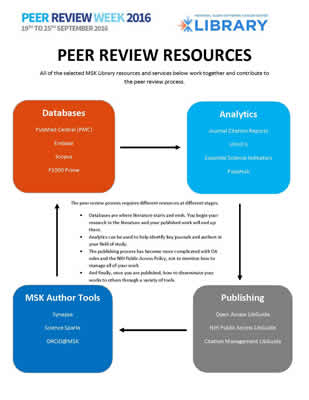 We hope you have enjoyed all the events during Peer Review Week here at MSK Library! Today gives you a chance to explore many of the library resources and services that work together and contribute to the peer review process. Click on the image to the right to download a handout and view all of the resource descriptions below the fold.
We hope you have enjoyed all the events during Peer Review Week here at MSK Library! Today gives you a chance to explore many of the library resources and services that work together and contribute to the peer review process. Click on the image to the right to download a handout and view all of the resource descriptions below the fold.
Databases:
PubMed Central (PMC) is the NIH’s digital archive of biomedical literature. While PubMed is a database of citations and abstracts, PMC is a free electronic archive providing free access to over 3 million full text articles. All required NIH Public Access Policy articles are included, as as many journals which deposit their complete contents into PMC.
Embase is a comprehensive bibliographic database of 8,500 international biomedical and pharmacology journals, encompassing 31 million records and 2.1 million conference abstracts.
Scopus is the largest citation index of peer reviewed literature (scientific journals, books, conference proceedings) in the fields of science, technology, medicine, social science, and the arts and humanities. It features tools to allow you to analyze and visualize research and provide insights. Compare authors, journals, and institutions across fields, track individual authors’ H-index, and much more.
F1000 Prime is a database of peer-nominated, peer-reviewed articles important in the areas of biology and medicine reviewed by “Faculty” of the world’s leading scientists and clinicians who rate the articles and explain their importance. Faculty and articles are divided into 40 Faculties (Subjects) and then further subdivided into 300 sections.
Analytics:
Journal Citation Reports (JCR),a part of the Web of Science platform, provides a way to evaluate journals in a quantifiable way using citations. Use JCR to identify and compare Impact Factor, as well as Immediacy Index, Half Life, Eigenfactor, and more, for journals across the biomedical field.
Ulrichsweb is a directory of serials, both print and electronic, with information about content, publishing, indexing, as well as whether they are referred.
Essential Science Indicators, a part of the Web of Science platform, provides a way to analyze research performance and trends in science. It can also rank top scientists, institutions, journals, and more, in 22 broad fields.
PubsHub is an author resource that provides statistics on journals such as Impact Factor, circulation, time to acceptance, and rejection rate.
Publishing:
Open Access LibGuide – An MSK library guide to Open Access, including links to OA resources, information about the different levels of OA, MSK paid subscriptions, and predatory journals.
NIH Public Access Policy LibGuide – An MSK library guide to the NIH Public Access Policy, including the history of the policy, how to submit a paper (Methods A, B, C, and D), compliance information (including MSK Core Grant), and links to a variety of helpful resources.
Citation Management LibGuide – An MSK library guide to help you choose a citation management system and get assistance for that software program. Software highlighted: EndNote, Refworks, Papers, Mendeley, F1000 Workspace, and Zotero.
MSK Author Tools:
Synapse is the MSK Library’s collection of MSK staff author profiles, providing access to an inventory of published content (2001 to present) from our researchers, clinicians, nurses, and healthcare professionals. Synapse allows you to find authors or groups of authors, subscribe to RSS feeds, search articles by DOI or PMID, connect to full text or order through Document Delivery, and export to citation management tools and My NCBI’s My Bibliography.
Science Sparks are images from MSK authors publications featured daily on the MSK Library website, as well as on plasma screens in the Cyber Library in Zuckerman Research Center. They are meant to showcase and promote research done at MSK.
ORCID@MSK is the MSK Library’s portal to ORCID (Open Researcher and Contributor ID). ORCID is a unique identifier to eliminate name ambiguity and improve discoverability of one’s research. ORCID@MSK is able to automatically populate ORCID records by bringing in content through Synapse.